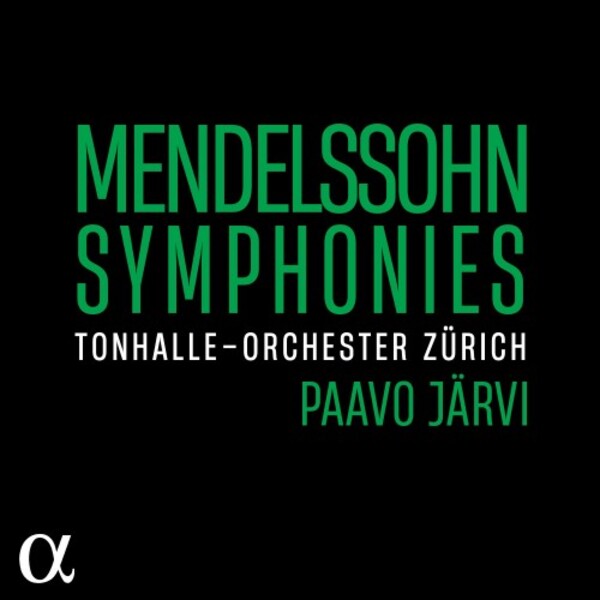MENDELSSOHN Symphonies (Järvi)
View record and artist detailsRecord and Artist Details
Genre:
Orchestral
Label: Alpha
Magazine Review Date: 05/2024
Media Format: CD or Download
Media Runtime: 231
Mastering:
DDD
Catalogue Number: ALPHA1004

Tracks:
| Composition | Artist Credit |
|---|---|
| Symphony No. 1 |
Felix Mendelssohn, Composer
Paavo Järvi, Conductor Zurich Tonhalle Orchestra |
| Symphony No. 5, 'Reformation' |
Felix Mendelssohn, Composer
Paavo Järvi, Conductor Zurich Tonhalle Orchestra |
| Symphony No. 2, 'Hymn of Praise' |
Felix Mendelssohn, Composer
Chen Reiss, Soprano Katharina Konradi, Soprano Marie Henriette Reinhold, Soprano Paavo Järvi, Conductor Patrick Grahl, Tenor Sophia Burgos, Soprano Zurich Tonhalle Orchestra |
| Symphony No. 3, 'Scottish' |
Felix Mendelssohn, Composer
Paavo Järvi, Conductor Zurich Tonhalle Orchestra |
| Symphony No. 4, 'Italian' |
Felix Mendelssohn, Composer
Paavo Järvi, Conductor Zurich Tonhalle Orchestra |
| A Midsummer Night's Dream - incidental music |
Felix Mendelssohn, Composer
Paavo Järvi, Conductor Zurich Tonhalle Orchestra |
Author:
These days we no longer need be defensive about the Reformation, trashed by Mendelssohn himself, or the symphony-cantata Lobgesang, once derided as a monument of Victorian complacency. More, perhaps, than any of his music, both works have benefited from the contemporary trend in Mendelssohn interpretation – lively tempos, transparent textures, pointed rhythmic articulation. The live cycle from Yannick Nézet-Séguin and the Chamber Orchestra of Europe set a modern Mendelssohn benchmark. Using a larger orchestra – around 70 players to the COE’s 45 – Paavo Järvi’s new Zurich studio cycle strikes me as comparably fine.
In cantabile themes – say, the Adagio of the Scottish or the romanticised minuet of the Italian, here played con amore – the Zurich strings produce a richer, deeper sonority than the lissom COE. Yet tonal warmth and, where needed, weight go hand in hand with that essential Mendelssohnian quality of airy lightness. Bass lines are nimble and expressively shaped; and violins are divided antiphonally throughout, to crucial advantage in passages such as the combative development in the Reformation’s opening movement (where Järvi is even more urgent than Nézet-Séguin) or the darting tarantella at the centre of the Italian’s saltarello finale.
From the initial whoop of joy to its più animato coda, the Italian’s first movement duly works its spell. Typically, Järvi creates pace without hurry, combining exhilarating impetus with flexibility of pulse. The development’s slow-burn crescendo and the characteristic poetic lull just before the recapitulation (6'50") are perfectly judged. In the finale Järvi risks a dangerously fast Presto and vindicates it with playing of fantastic precision and delicacy – sonic power, too, when the Roman revellers threaten to spiral out of control. Unlike Nézet-Séguin, Järvi observes Mendelssohn’s con moto request in the Andante, which unfolds here as a procession rather than a meditation.
‘Really childish’ was the pathologically self-critical Mendelssohn’s later verdict on his Symphony No 1, composed the year before the Octet. Mozartian pastiche parts of it may be. But it still impresses with its fluency and sophistication, especially in a performance as fiery and (in the Andante) eloquently sung as this. Nézet-Séguin and the COE are suaver, more Mozartian, stressing the affinity with Mozart’s Symphony No 40 in the Minuet where Järvi is more punchily Beethovenian.
Järvi passes my two key tests in the Scottish: songful innocence, without sentimentality, in the lovely Adagio and exultation rather than grandiloquence in the A major coda of the finale, high horns thrillingly to the fore. Järvi creates an ideal hushed tension at the start of the first movement’s Allegro un poco agitato and encourages a velvet pianissimo in that gorgeous cello countermelody in the recapitulation (from 10'59"). In the Scherzo the Zurich players (not least the first clarinet) match Nézet-Séguin’s COE in virtuoso élan and clarity of detail, while the main part of the finale, vivacissimo with a vengeance, is as bellicose and astringent as you will hear, punctuated by screeching brass discords and dry-rattling timpani.
Järvi’s performance of the Lobgesang is similarly compelling. Like Nézet-Séguin’s, his phrasing, sweeping across the bar line, minimises the potential rhythmic squareness of the first movement, here aquiver with nervous energy, and the big choruses. He catches the underlying poco agitato of the second movement where Nézet-Séguin prioritises grace, and chooses an unusually mobile tempo for the Adagio (no hint here of Mendelssohn’s prescribed religioso). Choir and soloists are all excellent. The solo sopranos blend enchantingly in the famous ‘Ich harrete des Herren’ (aka ‘I waited for the Lord’), here shorn of all mawkishness. If the soloists are rather too closely recorded, the Zurich Sing-Akademie make that much more impact than Nézet-Séguin’s RIAS choir, who suffer slightly in the resonant acoustic.
Ushered in by perfectly balanced wind chords, the Midsummer Night’s Dream music is as delectable as it should be: airborne rhythms and gossamer textures, plus just the right whiff of danger in the Scherzo and Intermezzo. The orchestra’s minute control of dynamics, including a feathery pianissimo, is a prime feature, both in the Dream music and throughout the symphonies. Any preference between Järvi and the chamber-scale performances from Nézet-Séguin will inevitably be personal. Both cycles are brilliantly executed and reveal a deep affinity with the composer’s spirit and distinctive sound palette. On disc, at least, Mendelssohn has never had it so good.
Explore the world’s largest classical music catalogue on Apple Music Classical.
Included with an Apple Music subscription. Download now.

Gramophone Digital Club
- Digital Edition
- Digital Archive
- Reviews Database
- Full website access
From £8.75 / month
Subscribe
Gramophone Full Club
- Print Edition
- Digital Edition
- Digital Archive
- Reviews Database
- Full website access
From £11.00 / month
Subscribe
If you are a library, university or other organisation that would be interested in an institutional subscription to Gramophone please click here for further information.




